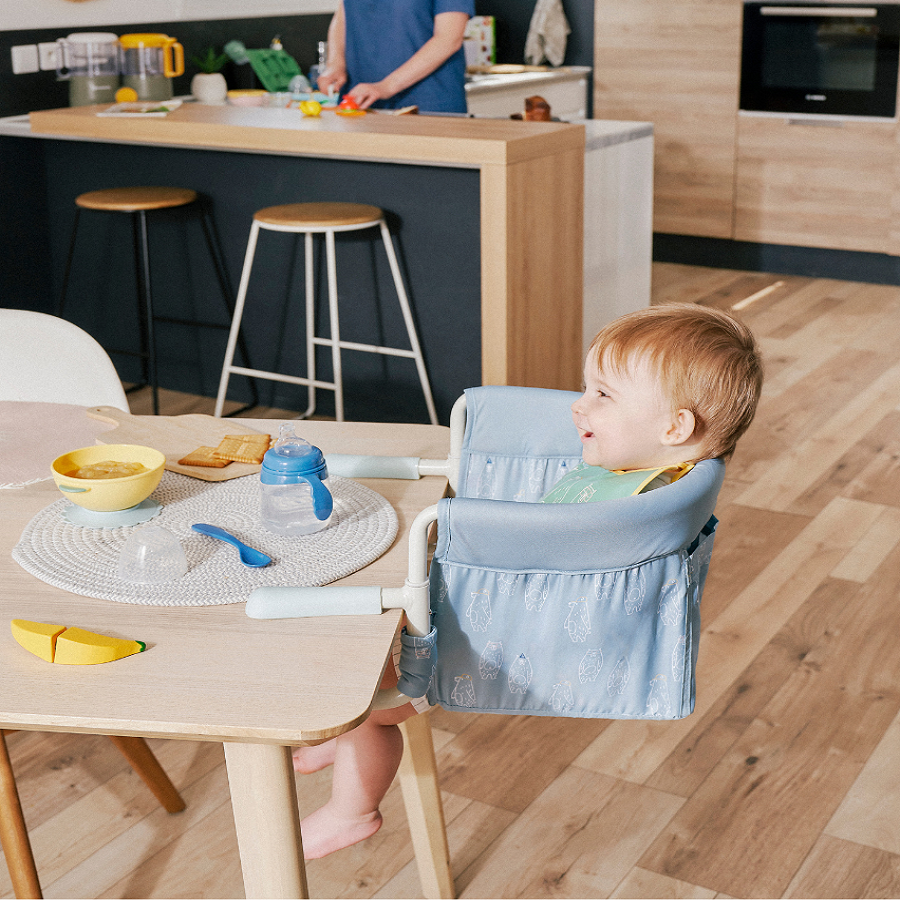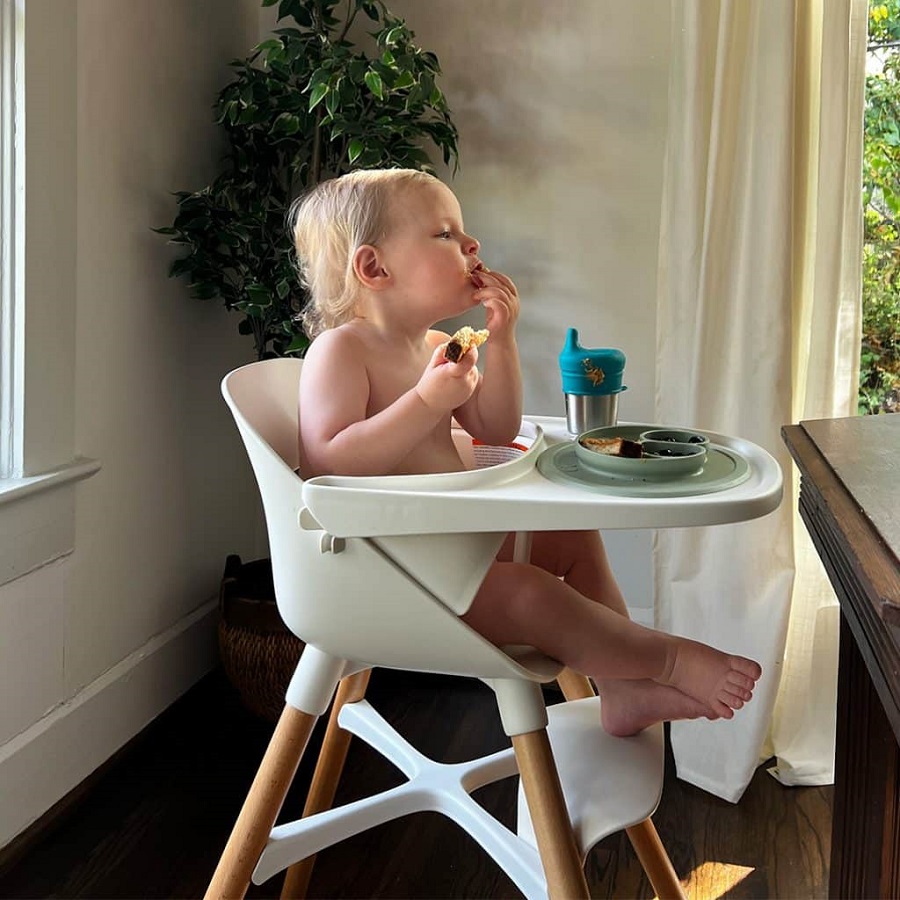Introducing a high chair to a baby’s routine is an exciting milestone that signifies the beginning of their journey into solid foods. Choosing the right time to transition your baby to a high chair and ensuring their safety are critical aspects of this process. This article explores the key milestones for introducing a high chair, safety considerations, and practical tips for a smooth transition.
Understanding the Right Time to Introduce a High Chair
Developmental Readiness for Solid Foods
Before introducing a high chair, it’s essential to ensure that your baby is developmentally ready for solid foods. Most experts recommend starting solids around 6 months of age. At this stage, your baby should have good head and neck control, which is crucial for sitting in a high chair safely. They should also be able to sit upright with minimal support and show interest in the foods you’re eating.
Developmental milestones such as the ability to hold their head up steadily and a diminished tongue-thrust reflex are indicators that your baby is ready for solid foods. This reflex, which causes a baby to push food out of their mouth, typically diminishes around 4 to 6 months of age. By this time, your baby’s digestive system is also mature enough to handle new textures and types of food.
Signs of Physical Readiness
Physical readiness for a high chair goes beyond developmental milestones. Observe your baby’s ability to sit with support and their physical stability when seated. They should be able to sit up with minimal assistance and have good trunk control. If your baby can maintain a seated position without slouching or leaning excessively, they are likely ready for a high chair.
Additionally, your baby’s weight and size play a role in high chair readiness. Most high chairs are designed to accommodate infants who weigh around 15 pounds or more. Ensure that your baby’s growth aligns with these specifications to ensure a safe and comfortable fit in the high chair.

Choosing the Right High Chair for Your Baby
Features to Look for in a High Chair
When selecting a high chair, consider features that enhance both safety and convenience. Look for a high chair with a sturdy frame and a stable base to prevent tipping. An adjustable harness system with a five-point safety belt is crucial for keeping your baby securely strapped in. Additionally, choose a high chair with adjustable height and recline positions to accommodate your baby’s growth and changing needs.
The ease of cleaning is another important feature. Opt for a high chair with a removable and washable tray and seat cover. Some high chairs come with a dishwasher-safe tray insert, which simplifies the cleaning process. Easy-to-wipe surfaces and detachable parts make maintenance more manageable and ensure a hygienic feeding environment.
Evaluating Material and Design
The material and design of the high chair impact both safety and comfort. High chairs made from durable materials like hardwood or high-quality plastic offer stability and longevity. Ensure that the materials used are free from harmful chemicals and are easy to clean. For added comfort, consider high chairs with padded seats and supportive backrests.
Design elements such as a removable tray and adjustable footrest contribute to the high chair’s functionality. A tray that can be easily removed and replaced helps facilitate feeding and cleaning. An adjustable footrest ensures that your baby’s feet are comfortably supported, promoting better posture and stability while eating.
Ensuring Safety While Using a High Chair
Proper Harnessing and Securing
One of the most critical safety aspects of using a high chair is ensuring that your baby is properly harnessed and secured. Always use the high chair’s five-point harness system to keep your baby safely in place. The harness should be snug but not too tight, allowing enough room for comfort without compromising safety. Regularly check the harness for any signs of wear or damage and ensure that it is properly adjusted to fit your baby as they grow.
Never leave your baby unattended in the high chair, even for a brief moment. Babies can move unexpectedly, and it’s crucial to ensure their safety at all times. Additionally, avoid using the high chair as a substitute for a play area or seat, as this can lead to accidents or injuries.
Preventing Tip-Overs and Falls
To prevent tip-overs and falls, place the high chair on a flat and stable surface. Avoid placing the high chair near edges or unstable surfaces where it could potentially tip over. Ensure that the high chair’s base is wide enough to provide stability and prevent accidental tipping.
Keep the high chair away from any potential hazards such as cords, appliances, or hot surfaces. Avoid using the high chair as a standing or climbing structure, as this can increase the risk of falls. Regularly inspect the high chair for any loose parts or malfunctions and address any issues promptly.

Transitioning to a High Chair: Practical Tips
Introducing the High Chair to Your Baby
Transitioning your baby to a high chair can be a smooth process with a few practical tips. Start by introducing the high chair during mealtimes when your baby is calm and hungry. Allow them to explore the high chair and get accustomed to sitting in it without the pressure of eating right away. Use positive reinforcement and praise to create a positive association with the high chair.
Consider using familiar objects, such as a favorite toy or a special cup, to make the high chair experience more enjoyable for your baby. Gradually increase the amount of time your baby spends in the high chair to help them adjust to the new seating arrangement.
Making Mealtimes Enjoyable
Creating a positive mealtime environment can enhance your baby’s experience with the high chair. Establish a consistent mealtime routine and provide a variety of age-appropriate foods to keep your baby engaged and interested. Encourage self-feeding by offering soft, easily grasped foods that promote independence and motor skills development.
Maintain a calm and relaxed atmosphere during mealtimes. Avoid distractions such as television or loud noises, and focus on interacting with your baby. Mealtime should be a pleasant experience that fosters bonding and encourages healthy eating habits.
Addressing Common Concerns and Troubleshooting
Handling High Chair Complaints and Issues
If you encounter issues with the high chair, such as difficulty cleaning or adjusting parts, refer to the manufacturer’s instructions for troubleshooting tips. Many common problems can be resolved with simple adjustments or by following proper cleaning procedures. If you experience persistent issues, contact the manufacturer’s customer service for assistance or consider replacing any damaged components.
Ensuring Longevity and Proper Maintenance
To ensure the longevity of your high chair, follow proper maintenance and care guidelines. Regularly clean the high chair to prevent the buildup of food residue and bacteria. Check for any signs of wear or damage and address them promptly. Store the high chair in a dry and safe location when not in use to prevent deterioration.
Consider upgrading the high chair as your baby grows or if their needs change. Some high chairs are designed to convert into toddler chairs or booster seats, offering extended usability. Evaluate your baby’s changing needs and adjust the high chair accordingly to ensure continued comfort and safety.

Conclusion
Introducing a high chair to your baby’s feeding routine is an exciting milestone that requires careful consideration of developmental readiness, safety features, and practical tips. By understanding when your baby is ready for a high chair, choosing the right model, and implementing safety measures, you can ensure a positive and enjoyable feeding experience. Transitioning to a high chair marks a significant step in your baby’s growth and development, making mealtimes more engaging and interactive. With proper care and attention, the high chair will become a valuable tool in fostering healthy eating habits and creating memorable mealtime experiences.
